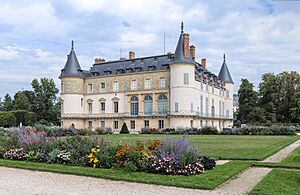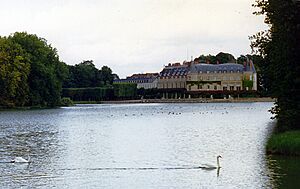Château de Rambouillet facts for kids
The Château de Rambouillet, also known as the Castle of Rambouillet, is a large castle in the town of Rambouillet, which is in the Yvelines area of northern France. It is about 50 kilometers (31 miles) southwest of Paris. For many years, from 1896 until 2009, it was the summer home for the Presidents of France. Today, a special organization called the Centre des monuments nationaux takes care of it.
Contents
History of Rambouillet Castle
Early Years of the Château
The Château de Rambouillet started as a strong, fortified manor house way back in 1368. Even though a part of it was removed during the time of Napoleon, it still has its original five-sided shape with strong walls. A famous French king, Francis I, passed away here on March 31, 1547. He likely died in the tall, old tower that is now named after him.
Later, the château was owned by Charles d'Angennes, who was the marquis de Rambouillet, during the reign of King Louis XIII. Long paths led from the castle's park directly into the nearby forest, which was full of animals for hunting. Today, more than 200 square kilometers (about 77 square miles) of this forest still remain. It is known as the Forest of Rambouillet.
A Royal Hunting Lodge
In 1783, the château became the personal property of King Louis XVI. He bought it from his cousin to make his hunting grounds even bigger. His wife, Queen Marie Antoinette, visited in November 1783. She famously said, "How could I live in such a gothic toadhouse!" She didn't like the old-fashioned look of the castle.
To make his wife happier, King Louis XVI secretly ordered the building of the famous Queen's dairy (Laiterie de la Reine). This was a special place where the queen could enjoy fresh milk and dairy products. The milk buckets were made of beautiful Sèvres porcelain and looked like wood. Inside, there was a marble statue of a nymph named Amalthea with the goat that cared for the god Jupiter. A small sitting room was also part of the dairy, with fancy chairs made in 1787.
Changes During the French Revolution
During the French Revolution, the Rambouillet estate became "national property," meaning it belonged to the government. The castle's furniture was taken away, and its gardens and park were not looked after.
Napoleon's Connection to Rambouillet
When Napoleon I was in charge, Rambouillet was added to his list of government-owned properties. The Emperor visited Rambouillet several times. His last visit was on the night of June 29–30, 1815, as he was on his way to be exiled to Saint Helena. You can still see reminders of Napoleon there, like his bathroom with a small bathtub and a beautiful balcony. This balcony was built to connect his apartment to that of his second wife, Empress Marie-Louise. Another reminder is the impressive avenue of bald cypress trees, which were planted in 1810.
Later Royal History
After Napoleon, during the time of the Bourbon Restoration, Rambouillet was again part of the royal properties. Fifteen years after Napoleon I, King Charles X also began his journey to exile from Rambouillet. On August 2, 1830, he signed his abdication here, giving up his throne to his nine-year-old grandson. It took him twenty minutes to convince his son to also give up his rights to the throne.
From 1830 to 1848, the Rambouillet estate was not part of King Louis Philippe I's royal properties. However, the townspeople asked Emperor Napoléon III, who ruled from 1852 to 1870, to include it again. He agreed.
The Château Becomes a Presidential Home
After Napoleon III's rule ended in 1870, the French Third Republic began. The Rambouillet estate was rented out from 1870 to 1883. In February 1896, President Félix Faure visited Rambouillet. He decided that he and his family would spend their summers there. Since then, the Château de Rambouillet became the summer home for France's presidents. They would host important guests and foreign leaders there, often inviting them to hunting parties. Because it was a part-time home for the French president, it was sometimes called the Palace of Rambouillet.
Rambouillet During World War II
On August 23, 1944, just two days before Paris was freed from occupation, General Charles de Gaulle arrived at Rambouillet. He set up his headquarters in the château. That evening, he met General Philippe Leclerc. General Leclerc was given the mission to free Paris with his French 2nd Armored Division. Part of this division left Rambouillet at dawn the next day to march towards Paris. On August 25, around 2 p.m., General de Gaulle left Rambouillet by car to enter "Paris liberated."
Modern Use and Important Meetings
In the 1960s, foreign leaders often stayed in the beautiful surroundings of the Château de Rambouillet. They were sometimes invited to hunt birds there in the autumn.
In November 1975, the first "G6" summit was held at the château. This was a meeting organized by French President Valéry Giscard d'Estaing for the leaders of the world's most developed countries. Leaders from the United States, the United Kingdom, Italy, Japan, and West Germany attended.
The Château de Rambouillet is still used today for important meetings between two countries. In February 1999, it hosted negotiations about Kosovo during the Kosovo War.
Hurricane Lothar's Impact
On December 26, 1999, a powerful storm called Hurricane Lothar hit the northern part of France. It caused a lot of damage to forests, parks, and buildings. The Forest of Rambouillet lost hundreds of thousands of trees. In the park of Rambouillet, over 5,000 trees were blown down, including the beautiful and historic bald cypress avenue that was planted in 1810.
|



